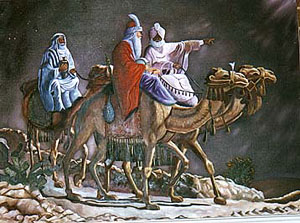Growing up in the States and not being on top of my religious celebrations and history, I didn't learn about this celebrated holiday until I started a family. My in laws, who are from the motherland, told me that they didn't observe "Christmas" until today, January 6th. I wanted to create an art piece in honor of this tradition, and am still going to work on it, but till then, I thought I would share the origins of this celebrated day.
By the way, Happy New Year! May your year be blessed with happiness, peace, creativity, love and prosperity!
Yoli
(original article by http://www.mexonline.com/history-lostresreyes.htm)
January the 6th is a special day in Mexico. Known as 'El Dia de Reyes' (Three Kings Day), this holiday represents the height of the Christmas season. The date marks the culmination of the twelve days of Christmas and commemorates the three wise men who traveled from afar, bearing gifts for the infant baby Jesus. The children of Mexico in particular look forward to this holiday as traditionally, gifts are exchanged on this date, not on Christmas day.
In Mexico and many other Latin American countries, Santa Claus doesn't hold the cachet that he does in the United States. Rather, it is the three wise men who are the bearers of gifts, who leave presents in or near the shoes of small children. The holiday is also known by the name of the Epiphany which dates back to the 4th century. A grand feast would be held on this day to honor the occasion of Jesus' baptism and to pay homage to the three wise men.
Many believe mysterious events preceded Jesus' birth with perhaps the most notable being the appearance of the Star of Bethlehem. This new star appeared in the evening sky just prior to the arrival of Jesus. Three wise men or Magi as they were then known, whose names were Gaspar, Melchior and Balthasar, traveled a far distance to pay homage to the Christ child. They brought with them fine gifts of gold, frankincense and myrrh.
Three Kings Day remains an important holiday for the people of Mexico. In addition to the gift-giving aspect of the day there is also a culinary treat that is specific to the holiday. Known as 'Rosca de Reyes' (King's Cake), this holiday dessert offers much in the way of symbolism. Shaped in the round to signify a king's crown, this sweet bread holds a special surprise. Baked inside is a small plastic figurine representing the baby Jesus. Whoever finds this token is obligated to host an upcoming party for the occasion of 'Dia de la Candelaria' (Candlemas Day) which occurs each year on February 2nd.
The effigy of the baby Jesus, hidden inside the cake, represents another aspect of the holiday. The reason Jesus is 'hidden' inside the bread is to symbolize how in life, the Christ child's birth location also needed to remain secret, in order that his life be spared. The ruler of Jerusalem at the time, King Herod, had been appraised of the mystical signs that indicated the new and rightful King of Jerusalem was soon to be born. Herod's reaction to these predictions was swift and horrible. He ordered his minions to murder all male infants recently born in Bethlehem. However, as destiny would have it, Mary and Joseph found their lodgings in a manger, not an inn. Herod's henchmen didn't think to look for an infant in such a location.
Another lovely custom associated with the Three Kings Day holiday centers around the evening meal. Traditionally, the supper served on this special day is delicious corn tamales accompanied by hot chocolate. This makes for a perfectly quintessential Mexican meal and one that is enjoyed by everyone in attendance.
By the way, Happy New Year! May your year be blessed with happiness, peace, creativity, love and prosperity!
Yoli
(original article by http://www.mexonline.com/history-lostresreyes.htm)
January the 6th is a special day in Mexico. Known as 'El Dia de Reyes' (Three Kings Day), this holiday represents the height of the Christmas season. The date marks the culmination of the twelve days of Christmas and commemorates the three wise men who traveled from afar, bearing gifts for the infant baby Jesus. The children of Mexico in particular look forward to this holiday as traditionally, gifts are exchanged on this date, not on Christmas day.
In Mexico and many other Latin American countries, Santa Claus doesn't hold the cachet that he does in the United States. Rather, it is the three wise men who are the bearers of gifts, who leave presents in or near the shoes of small children. The holiday is also known by the name of the Epiphany which dates back to the 4th century. A grand feast would be held on this day to honor the occasion of Jesus' baptism and to pay homage to the three wise men.
 | ||
| | ||
Three Kings Day remains an important holiday for the people of Mexico. In addition to the gift-giving aspect of the day there is also a culinary treat that is specific to the holiday. Known as 'Rosca de Reyes' (King's Cake), this holiday dessert offers much in the way of symbolism. Shaped in the round to signify a king's crown, this sweet bread holds a special surprise. Baked inside is a small plastic figurine representing the baby Jesus. Whoever finds this token is obligated to host an upcoming party for the occasion of 'Dia de la Candelaria' (Candlemas Day) which occurs each year on February 2nd.
 | ||
| | ||
Another lovely custom associated with the Three Kings Day holiday centers around the evening meal. Traditionally, the supper served on this special day is delicious corn tamales accompanied by hot chocolate. This makes for a perfectly quintessential Mexican meal and one that is enjoyed by everyone in attendance.
Comments